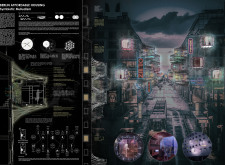5 key facts about this project
Unique Community-Centric Design Approaches
A fundamental aspect of this project is its emphasis on communal living. The architectural design incorporates shared spaces, such as co-working areas, lounges, and rooftop gardens that encourage social interaction among residents. This approach is instrumental in promoting a sense of belonging and cooperation in urban settings.
In terms of materiality, the project employs a combination of steel, glass, concrete, and recycled materials. The use of a steel framework allows for open layouts while maintaining structural integrity. Large glass elements provide both transparency and abundant natural light, enhancing the livability of the spaces. Incorporating recycled materials underlines the project's dedication to sustainability and environmental responsibility.
Vertical gardening serves as a significant feature throughout the design, adding green spaces that contribute to urban biodiversity and improve air quality. This distinct integration of nature within the architectural framework sets this project apart from conventional housing developments, which often neglect ecological considerations.
Functional and Adaptive Design Elements
The architectural plans detail modular units designed for flexibility, accommodating various household sizes and needs. This adaptability addresses the diverse demographic of Berlin and allows residents to personalized living experiences. The design supports high-density living while maintaining privacy through careful spatial arrangement.
Architectural sections reveal how the stacked configuration of units maximizes views and ventilation, aligning the project with principles of sustainable housing design. Green roofs contribute to thermal regulation, while also serving as communal gardens for residents. These features distinguish the project from standard affordable housing models that typically prioritize cost over livability and sustainability.
The Berlin Affordable Housing project exemplifies a holistic approach to urban residential design. The combination of community-oriented spaces, ecological principles, and adaptable units makes it a noteworthy study in modern architecture. For an in-depth look at the architectural designs, detailed architectural plans, and sections of this project, readers are encouraged to explore the full presentation to gain more insights into the innovative ideas driving this initiative.























